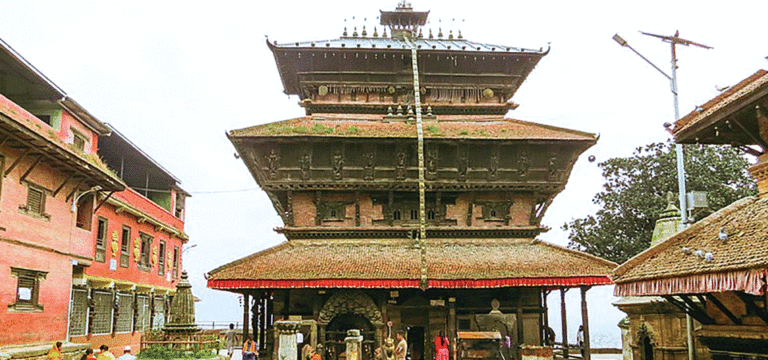
At Tajaph Tole of Kirtipur, there’s a small courtyard known as the Yaka Baha. At first glance, the place appears to have nothing extraordinary. But the Baha is regarded as one of Kirtipur’s most important destinations. It is also listed in the Kirtipur Municipal Heritage Bylaws as being the core area among 19 other cultural sites including Chilancho Stupa, Uma Maheshwari and Bagh Bhairab Temple.
“The courtyard houses the Jibadharma Vihara, which was constructed in NS 767 (the 1640s approx). King Sidhinarshingh Malla himself is said to have attended its consecration ceremony,” informed Rupak Maharjan, President of Kirtipur Guide Association. Apart from the vihara, the Baha is also famous for one of the finest pieces of woodcraft in Kirtipur. However, the cultural site is now in disarray. Ivy covers the decrepit walls and weeds invade the ground on all sides. The once tasteful window now stares like empty eye socket with rotting vines running down like slimy tears.
The fate of Yaka Baha is similar to other sites in Kirtipur, which has taken a back seat to urban life and development. While the quaint historic city is dotted with such wonderful cultural sites it is still only nominated in the tentative list of the UNESCO World Heritage Sites.
About 12 years ago, the Department of Archaeology prepared a report to enlist Kirtipur as a World Heritage Site in January of 2008, but to no avail. Since then, the city has undergone remarkable changes. Old traditional structures like Yaka Baha have been replaced by modern buildings. Modern style has obscured originality, which is seen as a major hurdle barring Kirtipur from being identified as a cultural conservation area, according to Maharjan.
However, as part of its Punarjagaran Abhiyan (Revival Campaign), the Kirtipur Municipality has placed preservation of historical and cultural monuments as its top priority. According to Mayor Ramesh Maharjan, the residents today adhere to the ‘Building and Planning Bylaws’, which encourages new houses to incorporate traditional elements of architecture. The bylaws state that the façades of all new constructions inside the core zones and old settlements should be finished with clearly visible fair face brickwork. Likewise, no cement/lime plaster is allowed on the façade of any new or existing construction, and buildings with Reinforced Cement Concrete (RCC) and steel frame structure visible from outside are not allowed. While the bylaws were created in 2008, it finally became a norm after the devastating 2015 earthquake. “Now, the municipality pays close attention to the bylaws before approving any new building sites,” added Mayor Maharjan.
Apart from this, the municipality has recently formed a five-member task force under the chairmanship of Shree Krishna Maharjan to lead the campaign of establishing Kirtipur as a major heritage site of the Valley.
“The task force is responsible to carry out a thorough study of Kirtipur’s cultural sites, prepare a report and recommend Kirtipur to be enlisted as a heritage site,” informed Saraswati Khadka, Deputy Mayor and Spokesperson.
The task force hosted its first meeting on Saturday morning. “We have been consulting historians and cultural experts,” as per Shree Krishna Maharjan, who is spearheading the task force. The team has just recently concluded a field study of the Tokha Cultural Conservation Area. “We will also be visiting Panauti to understand what measures they have been following to retain its authentic art and culture,” he added.
Panauti has also been in the run for the UNESCO World Heritage Site. But unlike Kirtipur, Panauti has been on the tentative list since 1997 and even after all these years, it is yet to be enlisted.
“Maintaining authenticity is a challenge in this age of constant change and development. However, we have now started rebuilding decrepit monuments and have been focussing on rehabilitation of long-neglected aspects of our heritage,” said Mayor Maharjan.
The municipality has been turning its attention to a long-lost palace of Kirtipur, known as the Layakur Durbar. The age-old structure, which historians trace back to the supposed founder of Kirtipur, King Shiva Dev back in the 11th century, survives only in an old oil painting from the 19th century. After all these years, Kirtipur locals are looking to find concrete evidence of the fabled palace, and hopefully revive it from rubbles.
Bearing this in mind, just last week a team of Laxmi Kumari Basnet, Joint Secretary at the Ministry of Culture, Tourism and Civil Aviation, Saubhagya Pradhanang, Deputy Director-General of the National Archives, Subhadra Bhattarai, an official of the Department of Archaeology, and Engineer Shobha Maharjan visited Layaku area of Kirtipur and Deyapukhu area to monitor the possible excavation site.
Source : THE RISING NEPAL,





